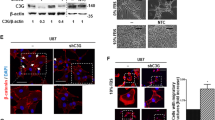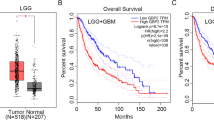Abstract
Amplification and mutation of the epidermal growth factor receptor (EGFR) are common features of malignant gliomas. The most frequent mutation seen in these tumors involves deletion of exon 2–7 resulting in a constitutively active form of the receptor (EGFRvIII, or deltaEGFR). Since EGFRvIII is found primarily in gliomas and has not been reported in sarcomas, we compared the effects of this altered receptor in immortalized primary astrocytes and fibroblasts. While EGFRvIII displayed ligand-independent autophosphorylation in both cell types, downstream signaling differed. While EGFRvIII increased the proliferative capacity of both astrocytes and fibroblasts consistent with activation of ERK in these cells, EGFRvIII activated AKT only in the immortalized astrocytes. EGFRvIII expression in astrocytes also led to increased radioresistance in that cell type. Furthermore, specific inhibition of phosphotidylinositol-3 kinase (PI-3K) with LY294002 reverted the radioresistant phenotype in the immortalized astrocytes. Thus, selective activation of PI-3K/AKT in astrocytes expressing EGFRvIII appears to be responsible for the observed increase in radioresistance. EGFRvIII's differential ability to activate the PI-3K downstream signal may explain why this mutant receptor is such a prominent lesion in malignant gliomas but less often seen in other tumor types, even those where EGFR signaling has a prominent role.
This is a preview of subscription content, access via your institution
Access options
Subscribe to this journal
Receive 50 print issues and online access
$259.00 per year
only $5.18 per issue
Buy this article
- Purchase on Springer Link
- Instant access to full article PDF
Prices may be subject to local taxes which are calculated during checkout






Similar content being viewed by others
Abbreviations
- EGFR:
-
epidermal growth factor receptor
- PI-3K phosphatidylinositol-3 kinase∣GBM:
-
glioblastoma multiforme
- hTERT:
-
human telomerase
- LT:
-
large T antigen
- NHA:
-
normal human astrocyte
- NHF:
-
normal human fibroblast
- EGF:
-
epidermal growth factor
- MTT, 3-(4,5-dimethylthiazol-2-yl)-2:
-
5-diphenyltetrazolium bromide
References
Antonyak MA, Moscatello DK and Wong AJ . (1998). J. Biol. Chem., 273, 2817–2822.
Brognard J, Clark AS, Ni Y and Dennis PA . (2001). Cancer Res., 61, 3986–3997.
Burns JC, Friedmann T, Driever W, Burrascano M and Yee JK . (1993). Proc. Natl. Acad. Sci. USA, 90, 8033–8037.
Chu CT, Everiss KD, Wikstrand CJ, Batra SK, Kung HJ and Bigner DD . (1997). Biochem. J., 324, 855–861.
Davis FG, Freels S, Grutsch J, Barlas S and Brem S . (1998). J. Neurosurg., 88, 1–10.
Fernandes H, Cohen S and Bishayee S . (2001). J. Biol. Chem., 276, 5375–5383.
Fine HA, Dear KB, Loeffler JS, Black PM and Canellos GP . (1993). Cancer, 71, 2585–2597.
Gupta AK, Bakanauskas VJ, Cerniglia GJ, Cheng Y, Bernhard EJ, Muschel RJ and McKenna WG . (2001). Cancer Res., 61, 4278–4282.
Hahn WC, Counter CM, Lundberg AS, Beijersbergen RL, Brooks MW and Weinberg RA . (1999). Nature, 400, 464–468.
Holland EC, Hively WP, DePinho RA and Varmus HE . (1998). Genes. Dev., 12, 3675–3685.
Humphrey PA, Wong AJ, Vogelstein B, Zalutsky MR, Fuller GN, Archer GE, Friedman HS, Kwatra MM, Bigner SH and Bigner DD . (1990). Proc. Natl. Acad. Sci. USA, 87, 4207–4211.
Jungbluth AA, Stockert E, Huang HJ, Collins VP, Coplan K, Iversen K, Kolb D, Johns TJ, Scott AM, Gullick WJ, Ritter G, Cohen L, Scanlan MJ, Cavanee WK and Old LJ . (2003). Proc. Natl. Acad. Sci. USA, 6, 6.
Klingler-Hoffmann M, Bukczynska P and Tiganis T . (2003). Int. J. Cancer, 105, 331–339.
Li J, Yen C, Liaw D, Podsypanina K, Bose S, Wang SI, Puc J, Miliaresis C, Rodgers L, McCombie R, Bigner SH, Giovanella BC, Ittmann M, Tycko B, Hibshoosh H, Wigler MH and Parsons R . (1997). Science, 275, 1943–1947.
Maehama T and Dixon JE . (1998). J. Biol. Chem., 273, 13375–13378.
Meyerson M, Counter CM, Eaton EN, Ellisen LW, Steiner P, Caddle SD, Ziaugra L, Beijersbergen RL, Davidoff MJ, Liu Q, Bacchetti S, Haber DA and Weinberg RA . (1997). Cell, 90, 785–795.
Moscatello DK, Holgado-Madruga M, Godwin AK, Ramirez G, Gunn G, Zoltick PW, Biegel JA, Hayes RL and Wong AJ . (1995). Cancer Res., 55, 5536–5539.
Myers MP, Pass I, Batty IH, Van der Kaay J, Stolarov JP, Hemmings BA, Wigler MH, Downes CP and Tonks NK . (1998). Proc. Natl. Acad. Sci. USA, 95, 13513–13518.
Myers MP, Stolarov JP, Eng C, Li J, Wang SI, Wigler MH, Parsons R and Tonks NK . (1997). Proc. Natl. Acad. Sci. USA, 94, 9052–9057.
Nagane M, Coufal F, Lin H, Bogler O, Cavenee WK and Huang HJ . (1996). Cancer Res., 56, 5079–5086.
Nagane M, Levitzki A, Gazit A, Cavenee WK and Huang HJ . (1998). Proc. Natl. Acad. Sci. USA, 95, 5724–5729.
Narita Y, Nagane M, Mishima K, Huang HJ, Furnari FB and Cavenee WK . (2002). Cancer Res., 62, 6764–6769.
Nelson DF, Diener-West M, Horton J, Chang CH, Schoenfeld D and Nelson JS . (1988). NCI Monogr., 279–284.
Rich JN, Guo C, McLendon RE, Bigner DD, Wang XF and Counter CM . (2001). Cancer Res., 61, 3556–3560.
Sonoda Y, Ozawa T, Aldape KD, Deen DF, Berger MS and Pieper RO . (2001a). Cancer Res., 61, 6674–6678.
Sonoda Y, Ozawa T, Hirose Y, Aldape KD, McMahon M, Berger MS and Pieper RO . (2001b). Cancer Res., 61, 4956–4960.
Stambolic V, Suzuki A, de la Pompa JL, Brothers GM, Mirtsos C, Sasaki T, Ruland J, Penninger JM, Siderovski DP and Mak TW . (1998). Cell, 95, 29–39.
Steck PA, Pershouse MA, Jasser SA, Yung WK, Lin H, Ligon AH, Langford LA, Baumgard ML, Hattier T, Davis T, Frye C, Hu R, Swedlund B, Teng DH and Tavtigian SV . (1997). Nat. Genet., 15, 356–362.
Tezuka M, Watanabe H, Nakamura S, Yu D, Aung W, Sasaki T, Shibuya H and Miura M . (2001). Clin. Cancer Res., 7, 3206–3214.
Vermeulen K, Berneman ZN and Van Bockstaele DR . (2003). Cell Prolif., 36, 165–175.
Wong AJ, Bigner SH, Bigner DD, Kinzler KW, Hamilton SR and Vogelstein B . (1987). Proc. Natl. Acad. Sci. USA, 84, 6899–6903.
Wong AJ, Ruppert JM, Bigner SH, Grzeschik CH, Humphrey PA, Bigner DS and Vogelstein B . (1992). Proc. Natl. Acad. Sci. USA, 89, 2965–2969.
Wu X, Senechal K, Neshat MS, Whang YE and Sawyers CL . (1998). Proc. Natl. Acad. Sci. USA, 95, 15587–15591.
Acknowledgements
We thank Jolene Okaneku for technical assistance. We are grateful to Dr Robert Weinberg (MIT) for kindly providing us with expression constructs for large T antigen and human telomerase and Dr Ruth Muschel (University of Pennsylvania School of Medicine) for providing us with human fibroblast cells. We thank Dr Amit Maity (University of Pennsylvania School of Medicine) for stimulating discussions and helpful suggestions and Dr W Gillies McKenna (University of Pennsylvania School of Medicine) for overall support of this work. This work was supported in part by grants from the American Society for Therapeutic Radiology and Oncology, The Brain Tumor Society and the American Brain Tumor Association to HGS.
Author information
Authors and Affiliations
Corresponding author
Rights and permissions
About this article
Cite this article
Li, B., Yuan, M., Kim, IA. et al. Mutant epidermal growth factor receptor displays increased signaling through the phosphatidylinositol-3 kinase/AKT pathway and promotes radioresistance in cells of astrocytic origin. Oncogene 23, 4594–4602 (2004). https://doi.org/10.1038/sj.onc.1207602
Received:
Revised:
Accepted:
Published:
Issue Date:
DOI: https://doi.org/10.1038/sj.onc.1207602
Keywords
This article is cited by
-
The development of dendritic cell vaccine-based immunotherapies for glioblastoma
Seminars in Immunopathology (2017)
-
Interleukin-13 receptor alpha 2 cooperates with EGFRvIII signaling to promote glioblastoma multiforme
Nature Communications (2017)
-
Cooperative effect of BI-69A11 and celecoxib enhances radiosensitization by modulating DNA damage repair in colon carcinoma
Tumor Biology (2016)
-
EGFR wild type antagonizes EGFRvIII-mediated activation of Met in glioblastoma
Oncogene (2015)
-
Radiosensitivity enhancement of radioresistant glioblastoma by epidermal growth factor receptor antibody-conjugated iron-oxide nanoparticles
Journal of Neuro-Oncology (2015)



